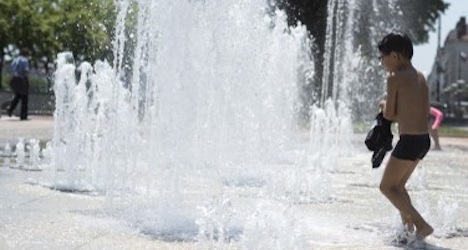The office raised the heatwave danger level to four (out of a scale with five as a maximum) for the next several days in regions below 800 metres, including all the major Swiss cities as of Thursday.
Geneva registered a high of 35.1C at around 4pm on Wednesday and the cities of Basel and Sion recorded similar top temperatures of around 35C, MeteoSwiss said.
Wednesday was the hottest day in Switzerland so far this year and the country has never experienced weather so warm on July 1st since records have been kept, website MeteoNews said.
With temperatures expected to spike even higher by Saturday, when the forecast high for Basel is close to 39C and 38 degrees for Geneva, cantonal authorities have put into action heatwave emergency plans.
The plans vary in detail but essentially advise residents to take special measures for the most vulnerable members of the population, including dependent seniors, children under the age of four, infants and people working outside.
The canton of Geneva advised avoiding physical activities at the hottest times of the day, staying in the shade, closing windows and shutters during the day and opening them at night to encourage currents of air.
The majority of homes in Switzerland do not have air conditioning, although public places such as supermarkets, cinemas and museums usually do.
See also: HALF OF FRANCE ON ALERT AS MERCURY HITS 40
The Geneva cantonal medical office recommended adults drink at least 1.5 litres of water per day and to avoid alcohol, which can cause dehydration.
Concern was raised for elderly persons, who are particularly vulnerable to hot spells.
When temperatures reach above 30 degrees, the number of deaths of seniors can rise by 10 percent above the normal rate, the Pro Senectute advocacy group said in a statement.
This is based on the experience of 2003 when thousands of elderly people died across Europe during a week-long heatwave.
Many elderly people are not equipped to deal with high temperatures because they have “poorer thermoregulation, they sweat less and have a decreased sense of thirst” compared to the rest of the population, the group said.
“They are therefore dependent on the attention of relatives, neighbours and caregivers.”
Authorities also said the heat was contributing to higher air pollution levels in various parts of Switzerland.
Concentrations of ozone measured at many stations on Wednesday afternoon rose above 180 grams per cubic metre, one and a half times the acceptable limit, the conference of cantonal directors of public works, land management and the environment said.
The level reached as high as 231 grams in Mendrisio in the canton of Ticino, and measured 201 grams in the Thônex-Foron area of the canton of Geneva, the conference said in a news release.
The directors advised people to reduce activities such as driving or using lawn mowers to reduce polluting emissions.
In the canton of Graubünden in eastern Switzerland, officials say the danger of forest fires has risen to a level three alert (on a scale of one to five).
The hotter than normal weather is expected to last for at least five days, Swiss weather forecasters say.




 Please whitelist us to continue reading.
Please whitelist us to continue reading.
Member comments